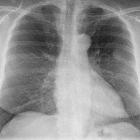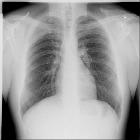pleurale Lipome
















Pleural lipomas are the most common benign soft tissue tumor of the pleura. These lesions are thought to originate from the submesothelial layers of the parietal pleura, extending into the subpleural, pleural, or extrapleural space. Pleural lipomas are encapsulated fatty tumors with a slow growth rate.
Clinical presentation
Normally asymptomatic and detected incidentally. In some cases, it causes pleural irritation with an urge to cough. When large, it can cause chest heaviness, dyspnea and breathlessness .
Radiographic features
Plain radiography
- well-defined, convex lesions forming obtuse angles with the pleura
- normally vertically oriented in relation to the chest wall
- no rib erosion
- appears denser than fat because of interface with air in the lung
Cross-sectional imaging
- homogeneous fat density or fat signal intensity
- no enhancement
Treatment and prognosis
They are thought to never transform into a sarcoma. Traditionally, management consisted of either doing nothing or observation. Recently, it has been suggested that this stance should be reconsidered due to their potential to grow, and due to the advances in video-assisted thoracic surgery .
Differential diagnosis
The principal differential diagnoses are those of single pleural masses. However, fat-containing lesions of the chest (e.g. hamartoma) should also be considered.
Extrapleural fat represents fat outside the parietal pleura. It is part of the loose connective tissue of the endothoracic fascia, most abundant along the posterolateral aspects of the 4 through 8 ribs. Extrapleural fat is typically bilateral, symmetrical, and located along the mid-lateral chest wall .
See also
Siehe auch:
- Lipom
- Hamartom
- solitärer fibröser Tumor der Pleura
- benigne pleurale Tumoren
- einzelne Pleuraraumforderung
- Tumoren der Pleura
- Lipom der Thoraxwand
- pleurale Lipomatose
- intrathorakales Lipom
- interkostales Lipom im Muskel
- epipleurales Fett
und weiter:

 Assoziationen und Differentialdiagnosen zu pleurale Lipome:
Assoziationen und Differentialdiagnosen zu pleurale Lipome:







